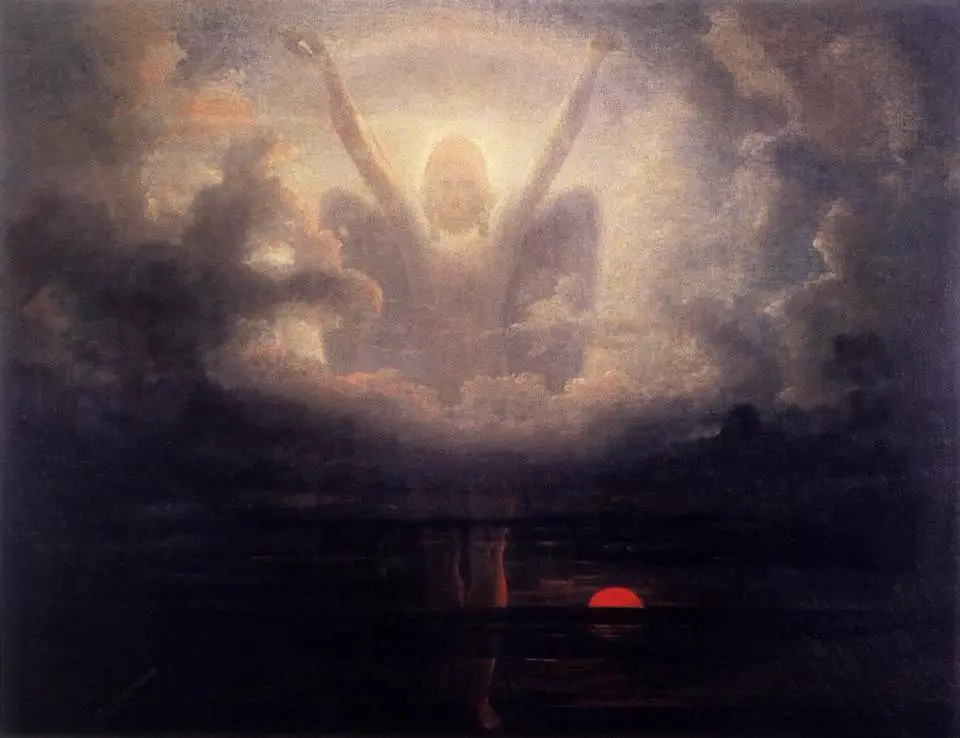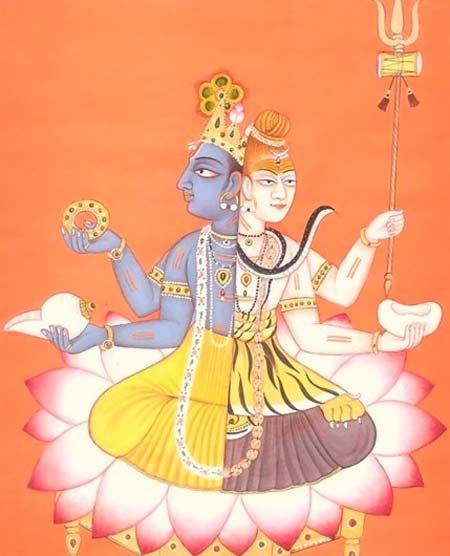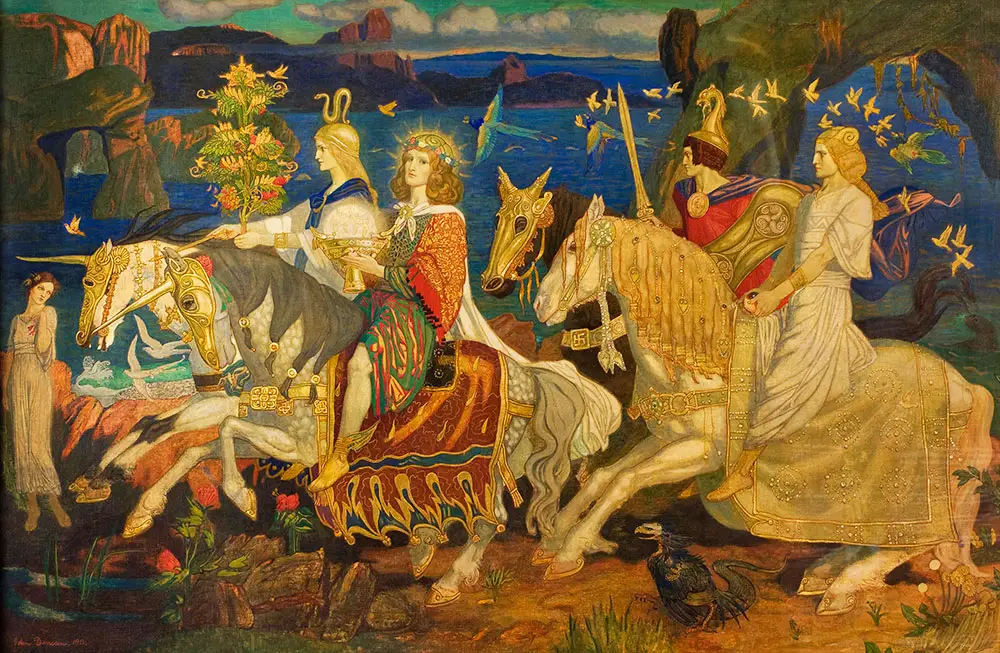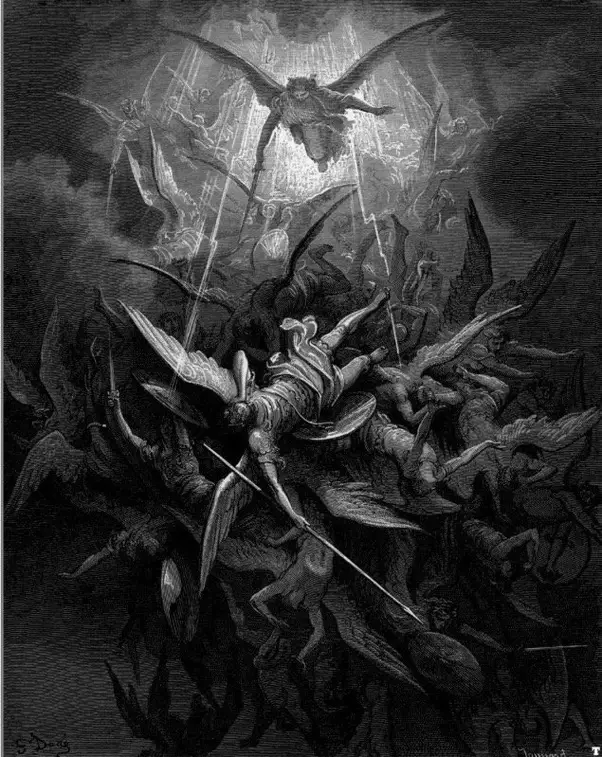In this fourth appointment of the “Manvantara” cycle, we analyze the theme of the fall of being into matter, starting with its most famous symbol: the rebellion of Lucifer and the Fallen Angels.
di Michael Ruzzai
originally published on Heretics Mind
cover: Gustave Moreau, “Prometheus”, 1868
In the previous article The Pole, the incorporation, the Androgyne we had alluded to the two points which, in the first chapter of Genesis, seemed particularly significant to us, namely the concept of "image of God" and the theme of androgyny of the first man. However, as is well known, there are several and further elements of an anthropogenic nature that are also exposed in the second chapter, which places us in front of the question of the underlying reasons for the presence of what actually appears to be a narrative repetition. Without wishing to enter into the merits of the various studies aimed at understanding the motivations on a philological and literary level (such as, for example, those based on the writing styles of the Old Testament and on the methods of composition of a material that, originally, must have been somewhat heterogeneous), here we are above all interested in trying to grasp, as far as possible, the deeper realities hinted at by the written letter, also in the light of other traditional sources.
A consideration that, for example, seemed to us of considerable interest on the nature of the hiatus between the first and second chapter of Genesis, is that of Jakob Böhme who interpreted it as the temporal space (or a-temporal?) During which occurred the fall of the angel Lucifer, an event in relation to which, moreover, matter would be generated. The fall of the angel and the "diabolical" action carried out by it - from the Greek devil, whose meaning is roughly "the one who divides, who gets in the way" - implies the entry into the field of the ambivalent demiurgic figure who, as Guénon recalls, produces first of all the "division", a situation to which all of us now we cannot escape, as he is in fact the "Prince of this world".

Below, we will therefore try to develop a series of considerations regarding the mythical figures involved who, as we will see, often seem to merge, overlap with each other, and carry out apparently conflicting and ambivalent actions. The starting element that in any case seems to be preliminarily emphasized is that there is the possibility of a double view.
The first, as we saw in the previous article, is that relating to one primordial and unitary consciousness, where subject and object, principle and manifestation, are not distinguished, and a Man - an androgynous Adam - evidently very different from the current one, still preserves intact and innate the spiritual faculty of intelligible, or rather to grasp the truths and phenomena "from within", without the need for any sensory mediation. Of Being and Living the Whole at the same time, if this synthesis is allowed to us.
The second, proper to our current and ordinary condition, is instead the subject-object separative view or, cosmologically, Principle-Manifestation: on this level, therefore, the perspective of a supreme and transcendent Principle derives, whose image is constituted by the Primordial Androgyne, which in practice is the highest aspect of its manifestation. Mircea Eliade recalls that the primordial and androgynous state was the one prior to "Individualization" and therefore if, with the categories taken up by Guénon, we interpret this term as a synonym of "formal" manifestation, then the Androgyne can be understood as pertinent to the "informal" manifestation, analogous, in Christian terms, to the angelic one, of a universal character and "supraindividual". This image appears androgynous but also, as in a game of optical refractions, in turn "principial" in relation to the lower levels of the manifestation itself.

If now, as a result of the aforementioned "demiurgic division", with the relative and inevitable dual perspective to which we must submit, we place the observation from the point of view of manifestation, the First Principle is grasped only as one of the two poles of Being (for example, pictured in Hindu couple Purusha – Prakriti, or also, respectively, in the Center and in the Circumference of the figure of the Circle), and therefore this view brings with it the correlative definition of an intermediate "space", so to speak, and the connected possibility of its double actualization. Double possibility that the demiurgic power is covered "simultaneously" and a-temporally, because otherwise it would not be "ambivalent" from an external observation, as ours is.
Or we can resort to another representation of this concept: one "aspect" of the Demiurge follows a path, the other "aspect" follows another, obligatory and innate itineraries to this level of existence which, we repeat, must necessarily undergo to the dual perspective. To make a comparison in the "microcosmic" field (but we think that the analogy may be relevant), this also happens within Man, as recalled by AK Coomaraswamy, in relationship that is established between the immortal, central and principial Self and all that series of "breaths" (the Maruts) that depend on it and which correspond to as many visual, auditory, thinking faculties, etc., which make up that extremely heterogeneous team which, in the end, is our "soul": that is, it happens that the Maruts can obey the Principle that governs them, but they can also rebel against it.
In the same order of considerations, in our opinion, what Jakob Böhme is the ambivalence of the Serpent - typical demiurgic figure - that among its possibilities it has both that of appearing as a celestial virgin, but also of being a symbol of a malign femininity; and Julius Evola does not fail to also provide an idea in this direction, when for example he remembers that some Celtic legends identified the divine Tuatha de Danann with fallen angels or descended from heaven with the Grail: spirits condemned to fall to earth because they were guilty of following Lucifer or because they remained neutral at the time of his rebellion. Well, a Celtic source defines the Tuatha de Danannsignificantly and simultaneously "gods and false gods", while other Christianized Celtic texts do not hesitate to even define them as "demons".

Ultimately Ugo Bianchi reminds us as the figure who has been defined in the field of ethnological studies "demiurge-Trickster" should not be confused or reduced to that of a purely destructive and diabolical being, being instead a character who rather presents "Promethean-Epimetean" aspects: in itself it is remarkably ambivalent, often malignant and animated by a spirit of rivalry, but elements of human existence and culture today essential and indispensable are also traced back to him.
So here are quickly outlined what we believe may have been "Two ways" simultaneously traveled by the Demiurge: one is that "negative", where he does not recognize himself as an image of the Principle and only looks "separatively" at himself, falling. The other one is that "Positive", in which he does not turn away from the Androgyne, he recognizes it as a direct image of the Principle and, identifying with it, takes it as a model and becomes an instrument for working in matter, as we will see later.
Let us dwell for a moment on some aspects related to the "negative possibility" of the Demiurge. René Guénon recalls that God ordered the angels to worship the primordial and prototypical Being - which in the Islamic tradition is the Universal Man - in his form, also defined here as spherical, representing the total manifestation; but, as we have already said, and also underlines Titus Burckhardt, the Universal Man is not really separate from God because he represents his face in all creatures. The rebel therefore refused to venerate the divine image that was in Adam, although he participated in that globality, since Böhme in fact recalls that angels also have human form, moreover represented in a supreme way by the most beautiful, Lucifer. His "envy", mentioned by Coomaraswamy, and the consequent insubordination, therefore takes the form of an act of pure denial, like not wanting to accept to conform, even if it is part of it, to that "All" made "in the image and likeness of God »: Lucifer therefore acts as the one who does not admit belonging to a given order of the Manifestation and denies obedience to an assigned role in the cosmic economy, preferring rather to affirm his own illusory individuality.
But in the moment in which Lucifer chooses his distinctive existence and not subordinate to the First Principle through the divine image, he can only precipitate. Concerning Lucifer's envy of Adam, Coomaraswamy proposed an interesting one "microcosmic" correspondence between Adam and the Spirit and between Satan and the Soul, representing the latter, in the context of the ternary Spirit-Soul-Body, the median part (analogous to psyche Greek), which Guénon reminds us of belonging to the domain of formal or individual manifestation, albeit "subtle" and not gross as heavy corporeality. In fact, even in the Koranic text there is a similar point, in that the refusal to bow before Adam, by the angel called Iblis, determines its fall and transformation into a Jinn, or rather in a being of the category of "Genes", immaterial entities that Titus Burckhardt points out as belonging to the psychic, intermediate world.
But the "diabolical" action, in addition to being pregnant with consequences on a cosmological level, at the same time also prepares the conditions for the subsequent anthropological human fall; it is no coincidence that Honorius of Regensburg, Leopold Ziegler and Martin Lings describe the descending movement as a process that develops in stages and ends with the definitive event of irreversible loss of the Edenic paradise (and within which, not surprisingly, the Snake is one of the creatures already present there).

According to traditions following Christ, collected and commented on by various authors, including Julius Evola and Mircea Eliade, the rebellious angels are approached to the "sons of God", or "sons of Elohim» (and, in this interpretative context, certain Syriac-Hebrew literature identifies the fallen angels also with the enigmatic "Watchmen"), who joined the "daughters of men", an event which in Genesis is barely narrated in the sixth chapter; elsewhere, Evola identifies the rebel angels with i Nephelin (Giants), the Titans Hellenic and, again, "those who watch" with men who in ancient times were "glorious" (always mentioned in the sixth chapter of Genesis) reading this "glorious" phase as the golden and androgynous-primordial one. An interpretation key, the Evolian one, which then overlaps the various actors on the scene, placing the accent on the basic unity of these entities, evidently narrated in the various traditional sources according to different aspects and perspectives, but never completely separable. 'from each other.
However, in this context one wonders who they correspond to the "daughters of men", since humanity in its present form does not yet exist. To this question, Evola replies that these female bodies can be interpreted with the same power of the rebel angels, a power that can etymologically be linked to material "potential" - traditionally always of a female sign - actually contained in themselves; a materiality which, however, probably still belongs to the "subtle" level of manifestation, since even according to Guénon the "Watchers", corresponding to the rebel angels, are entities belonging to the intermediate world. So a marriage of the children of Elohim with the daughters of men as one of the possible representations of that progressive materialization of the subtle and incorporeal Adamic entity: in fact, Frithjof Schuon also reminds us that the primordial age was such precisely because of its continuous opening between the top and the bottom, for this communication not yet interrupted with the subtle world and during which phenomena of this order could therefore easily be produced.
Although it is only narrated in the sixth chapter of Genesis, which occurs after the human exit from Eden, it is therefore probable that this union may concern, on a different ontological level, that is, on a "subtle" level, also situations of the beginning of Manvantara; but this does not prevent the event from having similarly reproduced at a later time and at a lower level, this time, however, between different actors, albeit in some way corresponding to the initial ones. Indeed, as a general method of analysis, it has been found that in traditional studies that must always be kept in mind law of analogy that makes possible a certain polyvalence of symbols and their interpretability on several levels, as well as the possibility that a particular element can be taken as a prototype of a larger set (or, vice versa, that from the more general case one proceeds by analogy towards a more specific and particular one).

This is therefore the "negative" way of the Demiurge, the one in which - summing up - the Angel does not recognize the image of the Principle and, following an "egoic" impulse, addresses / joins his own power, connoted in a "feminine" sense. Here he evidently corresponds to Lucifer, who thus falls to a lower level of manifestation, now of an "individual" order, that is, subject to the binding condition of "form", even if of a "subtle" level: that is, pertaining to that sphere which although it is not yet corporeal and completely densified, it is no longer of a spiritual order. Of this intermediate realm, Lucifer then becomes a demonic entity, e its fall generates at the same time the world of matter, in all its extensions, which will be resumed later.
But, on the sidelines of the Demiurge's negative way, we deem it appropriate to pause for a moment more on the theme of the union of the "sons of God" with the "daughters of men". As we know, this meeting traditionally leads to the origin of the "Giants": since however it must be said that, in the general literature, these entities have been interpreted in the most disparate ways, it is legitimate to ask ourselves now about who could have corresponded to them from the historical point of view- anthropological. In our opinion, a useful starting point to attempt an answer can indirectly come from the observation of Frithjof Schuon, who points out how Lucifer's refusal to bow before Adam could have produced the anticipated creation of a "parody" form of man; the perennialist thinker refers to the monkey, but we believe that the concept could also be extended to the subhuman anthropoid forms that the evolutionist view mistakenly considers the basis from which current humanity would have risen.
Probably other episodes handed down in the traditional corpus of various peoples can also go in the same direction, such as the one, mentioned by Ugo Bianchi, present in the Native American mythologies, where the Coyote (which plays a demiurgic role) tries to imitate the Divinity that he created man, but only managed to produce deformed beings. Schuon also notes the remarkable concordance between another Amerindian myth, in which il Great Spirit generated man in successive phases, however, each time destroying what had been done previously because abnormal creatures derived from it, with what is present from the Hindu Saura-Purana, where it is noted that in the auroral phase of each new creation, the lowest living forms emerge first, deriving from the Thomas. Tamas is in fact the shorter of the three use (the fundamental constitutive qualities of manifestation in the Hindu philosophical system Samkhya; the other two are slits e sattva) which, also for Evola, characterizes everything that is inert potentiality: probably, the same potentiality inherent in the "feminine" that led to the Luciferic fall and of which the dark side is represented by theriomorphic and monstrous creatures that in myths are always placed in auroral times. For his part, Julius Evola adds in fact how the subhuman anthropoid organisms would have represented the "first vanquished" in the anthropogenetic process, as populations that immediately appeared "degenerative" because overwhelmed by these "animal potentials" that primordial man brought in self.
A few other authors also noted how the mythical Giants might match the specs Neanderthal populations, as the word "giant" in this case should be interpreted not in a literal sense, but rather to emphasize concepts such as strength and courage (or, perhaps, even close to "brutality", or "elementary strength"?), since in Greek the word is expressed with the term kyklops. We also note that an interpretation of the Giants in a "subhuman" key - at least in this context and without necessarily having to exclude a different one (for example, the one proposed in our first article The end of the primordial age and the Fall of Man in relation to the Cro-Magnons) - could perhaps also provide an explanation for the hint, in truth always remained rather obscure, which in the sixth chapter of Genesis reads verbatim "There were giants on earth at that time, and even after ..."; that is, when the episode of the union between the sons of God and the daughters of men is placed on a more recent and post-Edenic chrono-ontological level, the biblical "antecedent" Giants would represent, in this case, the result of the union previously occurred, as hypothesized above, at the beginning of Manvantara and on the "subtle" plane.
Finally, this interpretation could also have some relationship with the frequent myths, actually quite paradoxical, as also underlined by the anthropologist Massimo Centini, of subhuman beings historically preceding present humanity, which however seem to have been particularly experts in the magical arts, at least in the coarser techniques of manipulating natural forces; that is, the hypothesis of some "operational" rudiments transmitted by the rebel angels to their imperfect descendants - and perhaps kept at a low, "witch-like" level - should not be excluded - which however would have represented a very early cultural stratification, then indirectly passed on to our ancestors as well Sapiens. Angelo Brelich, perhaps in relation to such a possibility, in fact mentions the at the same time superhuman and subhuman nature of the figure of the Trickster, while, on the other hand, it seems to us noteworthy and converging in the same direction, the fact that for example in medieval art depictions of men with marked semi-animal characteristics were often compared to Satan.

Bibliography:
- AA.VV. (edited by Ugo Bianchi) - The "double creation" of man in the Alexandrians, Cappadocians and gnosis - Edizioni dell'Ateneo & Bizzarri - 1978
- Ezio Albrile - Ahriman as “demiurge”: a dualistic anomaly? - in: Studies and materials of the history of religions, Vol. 58 - year 1992
- M. Barracano - Symbol, devil and tradition - in: Vie della Tradizione, n. 41 - January-March 1981
- Giulio Basetti-Sani - The sin of Iblis (Satan) and the angels of the Koran - Edizioni Iperbole - 1987
- Ugo Bianchi - Religious dualism. Historical and ethnological essay - University Editions - 1983
- Ugo Bianchi - Prometheus, Orpheus, Adam. Religious themes on destiny, evil, salvation - Edizioni dell'Ateneo & Bizzarri - 1976
- Angelo Brelich - Reviews and notes. The Trickster - in: Studies and Materials of the History of Religions, Vol. XXIX - year 1958
- Titus Burckhardt - The Universal Man - Mediterranean Editions - 1981
- Titus Burckhardt - The spiritual key of Muslim astrology - SE - 1997
- Titus Burckhardt - Symbols - Editions under the banner of Veltro - 1983
- Massimo Centini - The fallen angel - De Vecchi Editore - 2004
- Massimo Centini - The wild man - Mondadori - 1992
- Ananda Kentish Coomaraswamy - Who is Satan and where is Hell? - in: Journal of Traditional Studies, n. 43 - July / December 1975
- Ananda Kentish Coomaraswamy - Hinduism and Buddhism - Rusconi - 1994
- Ananda Kentish Coomaraswamy - The tree, the wheel, the lotus - Editori Laterza - 2009
- Bruno D'Ausser Berrau - De Verbo Mirifico. The Name and the Story - Document available online on various sites
- Mario Del Gatto - The Creation, the Man, the Fall - Atanor - 1990
- Mircea Eliade - The myth of reintegration - Jaca Book - 2002
- Mircea Eliade - History of religious beliefs and ideas. Vol. 1: From the Stone Age to the Eleusinian Mysteries - Sansoni - 1999
- Mircea Eliade - Treatise on the history of religions - Bollati Boringhieri - 1999
- Julius Evola - The mystery of the Grail - Mediterranean Editions - 1997
- Julius Evola - The Hermetic Tradition - Mediterranean Editions - 1996
- Julius Evola - The yoga of power - Mediterranean Editions - 1984
- Julius Evola - Metaphysics of Sex - Mediterranean Editions - 1996
- Julius Evola - Revolt against the modern world - Mediterranean Editions - 1988
- Faivre / Tristan (edited) - Androgynous - ECIG - 1986
- Roberto Fondi - Neandertal Brother - in: Systema Naturae. Annals of Theoretical Biology. Vol. 2 - year 1999
- Vittorino Grossi - Outlines of patristic anthropology - Borla - 1983
- René Guénon - Traditional forms and cosmic cycles - Mediterranean Editions - 1987
- René Guénon - The Demiurge and other wise men - Adelphi - 2007
- René Guénon - The symbolism of the Cross - Luni Editrice - 1999
- René Guénon - Initiation and spiritual realization - Luni Editrice - 1997
- René Guénon - Man and his becoming according to Vedanta - Adelphi - 1997
- René Guénon - The Great Triad - Adelphi - 1991
- René Guénon - Tradition and traditions - Mediterranean Editions - 2003
- René Guénon - Thoughts on esotericism - Fratelli Melita Editori - 1989
- Martin Lings - Ancient faiths and modern superstitions - The green lion - 2002
- Claudio Mutti - The Demiurge in the Magyar tradition - in: Heliodromos, n. 24 - December 1985
- Honorius of Regensburg - What is Man - The green lion - 1998
- Ugo Plez - Living prehistory - Mondadori - 1992
- Jean Robin - UFO. The great parody - Editions under the banner of Veltro - 1984
- Frithjof Schuon - From divine to human - Mediterranean Editions - 1993
- Frithjof Schuon - Images of the Spirit - Mediterranean Editions - 2006
- Frithjof Schuon - The stations of wisdom - Mediterranean Editions - 1983
- Site Gaianews.it - 15/8/2013 - Another discovery intensifies the mystery of the disappearance of the Neanderthals - Web address: http://gaianews.it/scienza-e-tecnologia/archeologia/neanderthal-unaltra-scoperta-intensifica-il-mistero-della-loro-scomparsa-44229.html#.UxrOHM6hbWo

5 comments on “The Demiurge and the Negative Possibility: Fall"